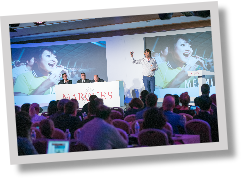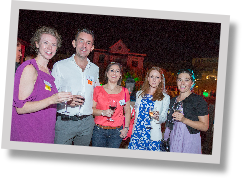MARQUES Chair Uwe Over opened the Conference, which took place in the Meliá Villaitana amid pools, palm trees and bright sunshine, by removing his neckwear and declaring it a “tie-less event”. He promised there would be no boring presentations during the week: “At MARQUES we do not have just a legal focus. We see brands from a social and psychological point-of-view.”
Trends and plans at EUIPO
 EUIPO Executive Director António Campinos followed Uwe’s sartorial lead. In a statistic-packed speech, he said that the Office saw an 11% increase in trade mark applications in 2015 and expects to receive about 145,000 applications this year. “This has an impact on the Office’s plans for staffing and budget,” he added.
EUIPO Executive Director António Campinos followed Uwe’s sartorial lead. In a statistic-packed speech, he said that the Office saw an 11% increase in trade mark applications in 2015 and expects to receive about 145,000 applications this year. “This has an impact on the Office’s plans for staffing and budget,” he added.
Mr Campinos focused in particular on the development of tools and convergence of practice between offices. He said this work had led to 14 to 15 new tools being introduced on average in each office, with 370 implementations in total.
The Office is now working towards the Strategic Plan 2020, which is built on the twin principles of “collaborative organisation and international cooperation”. On the latter point, Mr campinos said EUIPO is working to “promote positive change in the international context” by promoting tools and practices in areas such as China, India, ASEAN and Latin America.
Finally, he spoke of EUIPO’s growing role in areas other than trade marks, notably the proposed portal on copyright works, the Observatory study on litigation trends in trade secrets and the DesignEuropa awards taking place in Milan on 30th November. “We are adapting to an increasingly inter-connected, globalised world. What happens in one area of IP has consequences in another,” he said. “We want a future in which IP rights are accepted and recognised for their important role in society and the economy.”
Brands v trade marks
The conference theme “Brands versus Trade marks – Trade marks versus brands” was elaborated in the day’s second session, which featured speakers Ricardo Pérez of Millward Brown, Shane Smyth of FR Kelly and Antony Douglass of Specsavers. It was moderated by Mark Devaney of Bone-Knell Symons Intellectual Property.
Ricardo discussed how to turn “fluffy” notions of brands into money, and said brand power was achieved by being “meaningful, different and salient”. He offered 10 action points for building valuable brands (see box). Shane echoed this view, discussing the difference between brands and trade marks, saying: “We often cannot see the wood for the trees. We focus on legal issues such as registrability. That is not very high up a marketing agenda.” In a critique of recent legislative developments and cases he warned that trade mark law risked “penalising” companies that wanted to enhance their brands. “A brand can have attitude, a trade mark cannot,” he said.
One brand with attitude is Specsavers, and its in-house counsel told the audience about how it uses sports sponsorship, social media, parody and above all humour in its “Should’ve gone to Specsavers” advertising. The key, said Antony, is to be agile and fun: “We’re always on the lookout for new things and new ways of engaging with customers.”
| Ricardo’s 10 tips for building brands 1. Be purposeful. 2. Be authentic. 3. Be in the conversation. 4. Grow the triple bottom line (finance, social responsibility, environment). 5. Refine the brand experience. 6. Talk to individuals, not generations. 7. Use data respectfully. 8. Simplify the value exchange. 9. Change the transaction mindset. 10. Widen the competitive set. |
Benidorm and Brexit
Willem Leppink of Ploum Lodder Princen moderated a panel that discussed the latest trade mark policy issues, notably the EU trade mark reforms and the potential impact of Brexit.
 Dimitris Botis of EUIPO gave an update on the Delegated and Implementing Acts, saying the text is expected to be published soon. He focused in particular on the removal of the graphical representation requirement, saying the revised Article 3 “gives businesses sufficient freedom to protect what they need to and provides flexibility”. He also offered guidance on how the new rules could apply to 3D/shape marks, position marks, colours per se, sound marks and movement/multimedia/hologram marks, adding that other types of trade marks are not specifically regulated: “It’s difficult to see how they could be filed in the current state of technology.”
Dimitris Botis of EUIPO gave an update on the Delegated and Implementing Acts, saying the text is expected to be published soon. He focused in particular on the removal of the graphical representation requirement, saying the revised Article 3 “gives businesses sufficient freedom to protect what they need to and provides flexibility”. He also offered guidance on how the new rules could apply to 3D/shape marks, position marks, colours per se, sound marks and movement/multimedia/hologram marks, adding that other types of trade marks are not specifically regulated: “It’s difficult to see how they could be filed in the current state of technology.”
Kate Swaine of Gowling WLG and Diana Versteeg of Akzo Nobel discussed the implications of the UK Brexit referendum vote. Kate outlined seven possible options for dealing with EUTMs post-Brexit but urged brands owners: “Don’t panic!” Diana said in-house counsel would be looking at the bottom line: “All seven options will lead to an administrative burden and cost. Someone will have to bear the costs associated with those changes.”
Tove Graulund of Graulund Consulting asked several questions of the audience during a discussion that covered Article 28(8) declarations and other aspects of the reforms.
Updates on GIs and Madrid Protocol
 Are geographical indications and trade mark rights inevitably in conflict? That was the question addressed by panellists Óscar Modejar of EUIPO, Miguel Angel Medina of Elzaburu, Massimo Vittori of OriGIn and Alessandro Sciarra of Bird & Bird and chair Thera Adam van Straaten of Kneppelhout Korthals.
Are geographical indications and trade mark rights inevitably in conflict? That was the question addressed by panellists Óscar Modejar of EUIPO, Miguel Angel Medina of Elzaburu, Massimo Vittori of OriGIn and Alessandro Sciarra of Bird & Bird and chair Thera Adam van Straaten of Kneppelhout Korthals.
Drawing on case studies involving Champagne and Prosecco, the speakers concluded that there is too much emphasis on conflicts between GIs and trade marks, and that GIs in particular are poised to benefit from sustainable development challenges.
The day’s final session featured a lively discussion on some practical aspects of the Madrid Protocol, notably replacement, dependency (central attack) and transformation, with speakers Michael Leonard of Fox Rothschild, Debbie Rønning of WIPO and William Lobelson of Germain & Maureau. (See separate article in this issue from WIPO.)

The day closed with a Spanish-themed outdoor reception in the hotel, complete with sangria, paella and local handicrafts.
 Issue 069
Issue 069
 Issue 069
Issue 069